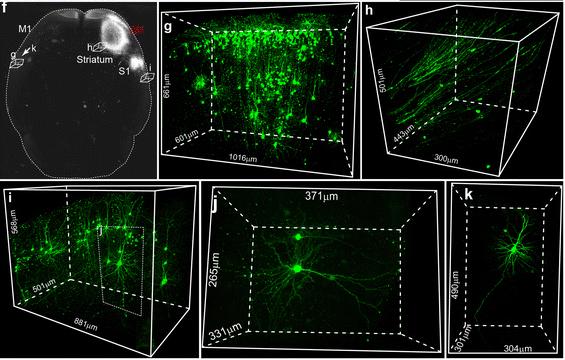Damage of brain connectome in neurodegenerative diseases remains unclear. Revealing the differences and abnormalities of neuronal circuits between healthy individuals and patients with PD or AD will contribute to understanding the mechanism(s) of these diseases. Mapping the brain connectome requires appropriate tracing tools, but the anterograde tracing tools are underdevelopment, and particularly, the monosynaptic anterograde tracer is still lacking.
In a joint study with Prof. XU Fuqiang from Wuhan Institute of Physics and Mathematics of the Chinese Academy of Sciences, the research group led by Prof. LUO Minhua from Wuhan Institute of Virology of the Chinese Academy of Sciences created the anterograde multi- and monosynaptic tracers derived from HSV-1 H129 strain.
Based on the bacterial artificial chromosome of H129, the scientists have generated a serial of recombinant viruses for neuronal circuit tracing. Among them, H129-G4 was obtained by inserting binary tandemly connected GFP cassettes into the H129 genome, and H129-ΔTK-tdT was obtained by deleting the thymidine kinase (TK) gene and adding tdTomato coding gene to the H129 genome. Then the obtained viral tracers were tested in vitro and in vivo for the tracing capacity.
They introduced a potential novel anterograde monosynaptic tracer H129-ΔTK-tdT and a bright anterograde multisynaptic tracer H129-G4. With helper virus complementarily expressing TK, H129-ΔTK-tdT can potentially transmit to the postsynaptic neurons, and enable visualization of direct projection targets of either a given brain nucleus or a specific neuron type. H129-G4 may label the multisynaptic projection circuit with high labeling intensify, which helps to visualize the details of neuron morphology along the circuits.
These novel anterograde tracers offer novel tools for projectome mapping, and complement the existing neuronal circuit tracing tool box.
The results have been published in Molecular Neurodegeneration entitled "Anterograde monosynaptic transneuronal tracers derived from herpes simplex virus 1 strain H129 ".
This work was supported by the National Program on Key Basic Research Project and the National Natural Science Foundation of China. Researchers from Wuhan National Laboratory for Optoelectronics, Peking University, Beijing Normal University and Kunming University of Science and Technology also participated in this study.

H129 derived tracer H129-G4. Image by LUO Minhua